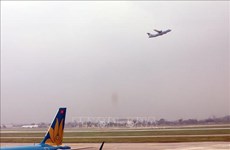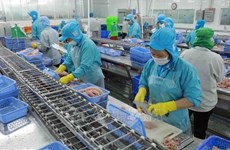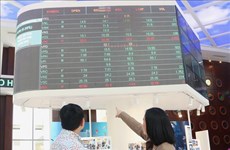Inbound flights schedules detailed
 Passengers conduct immigration procedures at Noi Bai International Airport (Photo: VNA)
Passengers conduct immigration procedures at Noi Bai International Airport (Photo: VNA)
Hanoi (VNA) – The Civil Aviation Authority of Vietnam (CAAV) has submitted detailed plans for flight schedules and requirements for airlines to bring foreign passengers into Vietnam, waiting for the Ministry of Transport’s approval.
There will be nine inbound flights a week landing in Hanoi and Ho Chi Minh City.
National flag carrier Vietnam Airlines and low-cost airline Vietjet Air will operate four flights to Hanoi every Tuesday, Wednesday and Thursday, with a maximum of 1,304 seats; and five flights to Ho Chi Minh City on Tuesday, Wednesday, Thursday and Friday with a total of 1,290 seats.
On September 11, the CAAV sent letters to the aviation authorities in Japan, China, Taiwan and the Republic of Korea detailing the plans.
Agreeing with Vietnam’s plans, China designated China Southern Airlines (code CZ) to operate Guangzhou-Ho Chi Minh City route, with one flight per week. Meanwhile, Japan assigned Japan Airlines (code JL) and All Nippon Airways (NH) to alternately run the Tokyo-Hanoi and Tokyo-Ho Chi Minh City flights on a weekly basis, with the frequency of one flight per week per route.
China’s Taiwan selected China Airlines (CI) and Eva Air (BR) to operate Taipei – Hanoi and Taipei – Ho Chi Minh City flights with the frequency of one flight per week on each route.
Airlines of the Republic of Korea will submit their operation plans to the CAAV in the coming time.
All airlines are ordered to ask their passengers to present their passports and entry visa granted by Vietnamese authorities.
The aviation authority also proposed tweaks to flights between Vietnam and Laos and Cambodia based on the request of the Vietnamese foreign ministry and the two neighbouring countries’ authorities.
Accordingly, Vietnam Airlines will operate the Phnom Penh-HCM City route (instead of Can Tho originally) and Vientiane-Hanoi (instead of Van Don).
Regarding “third country” entry, the CAAV mapped out three options:
Option 1: Disapproving transportation of “third country” passengers
Option 2: Approving transportation of “third country” passengers. Airlines must ask passengers to present their passports, entry visa, and proofs of a negative SARS-CoV-2 PRC test obtained three days prior to boarding during check-in procedures. A 14-day quarantine is required while short entry is not applicable for the passengers.
Option 3: Approving transportation of “third country” passengers. Airlines must ask passengers to present their passports, entry visa, and proofs of a negative SARS-CoV-2 PRC test obtained three days prior to boarding during check-in procedures. Short entry is not applicable for all passengers.
Airlines are asked to only process bookings for passengers who provide all necessary information – including the names and phone numbers of the passengers’ contacts in Vietnam, address and phone number of the quarantine facility they will stay in, and the phone number of the host organisation who will receive the passengers at the airport.
Passengers must produce documents proving they have been allowed to quarantine in facilities such as diplomatic representative’s buildings, factories, business headquarters, hotels or other similar accommodations, or concentrated quarantine facilities managed by the military.
Before boarding, passengers must wear masks, install the Vietnamese contact-tracing app Bluezone and the Vietnam Health Declaration app on their mobile devices, and fill out the health forms.
Airlines must carry out temperature checks and deny boarding for anyone with a temperature of more than 37.5 degrees Celsius.
Vietnamese and foreign airlines can only complete flight procedures for passengers with valid visas.
Airlines are told to monitor the health of the flight crewmembers after arrival into Vietnam, if the members show no signs of COVID-19 after 48 hours they could continue to work on other flights.
Currently, permitted entries to Vietnam are limited to foreign investors, business executives, experts, highly skilled workers, diplomats, international students – and their family – along with returning Vietnamese and their relatives.
International tourists are still not allowed in yet./.











